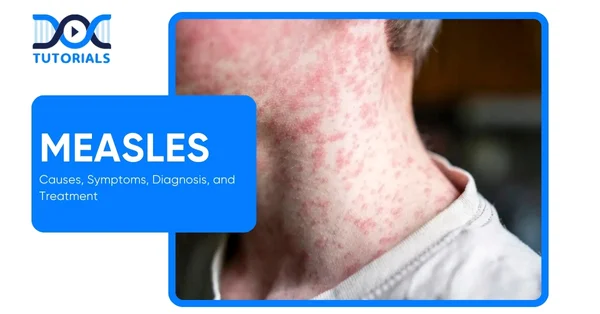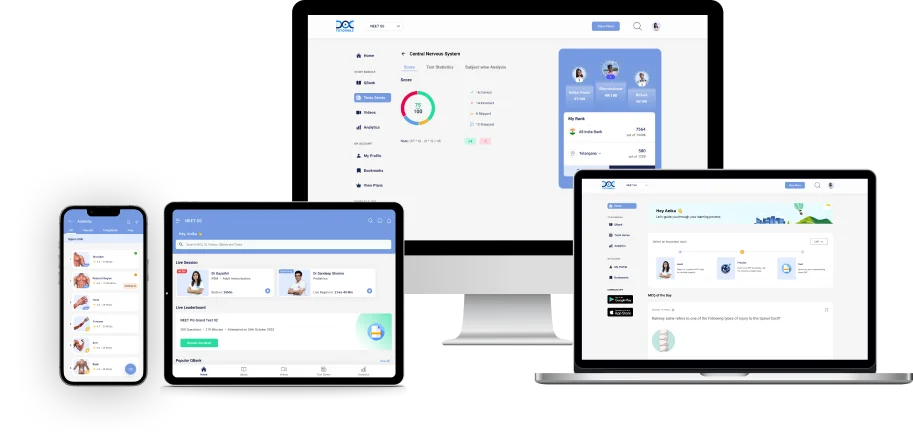Measles: Causes, Symptoms, Diagnosis, and Treatment

Measles is one of the most contagious viral infections worldwide, despite the availability of an effective vaccine. It was once regarded as a childhood disease, but it might cause severe illnesses, particularly in children under five and immunocompromised individuals.
Understanding the transmission, symptoms, diagnosis, complications, and treatment of diseases is essential for medical aspirants, not only to excel in their NEET PG exams but also to develop a strong clinical foundation.
This guide explores measles in a structured, exam-friendly format. Keep reading to know more about it!
What is Measles?
Measles is an acute, highly contagious childhood disease, characterised by fever and respiratory symptoms, followed by a typical maculopapular rash. It remains a major public health concern globally, particularly where immunisation coverage drops below recommended levels.
The virus is predominantly seeded in the epithelial surfaces of the body, including the skin, respiratory tract, and conjunctiva.
What are the Causes of Measles?
Measles is caused by the measles virus and is transmitted via respiratory droplets or airborne routes. The virus can remain viable in the air or on surfaces for up to two hours after an infected person coughs or sneezes.
The measles virus multiplies locally in the respiratory tract and then spreads to the regional lymph nodes. It enters the bloodstream through infected monocytes (primary viremia) and further multiplies in the reticuloendothelial system. The virus then spreads to the bloodstream (secondary viraemia) and disseminates to various sites throughout the body.
What are the Risk Factors of Measles?
Measles causative agent is an RNA virus that belongs to the Paramyxoviridae family:
- Close contact settings, such as schools, daycare centres, or refugee camps.
- Low community immunisation levels, falling below 95% coverage.
- Travel to endemic areas or contact with international travellers.
- Immunocompromised persons, who may present atypically or have prolonged infection.
Causes of measles include failure of vaccination programmes, waning immunity, and new importation of the virus into susceptible communities, including unvaccinated individuals, especially children under 5.
What are the Symptoms of Measles?
The incubation period of measles is about 10 days, which may be shorter in infants and longer (up to 3 weeks) in adults. Disease can be divided into three stages:
- Prodromal Stage
This stage lasts for 4 days (i.e., from 10th to 14th day of infection) and is characterised by manifestations such as:
- Fever is the first manifestation, occurring on day 1 (i.e., on the 10th day of infection)
- Koplik’s spots are pathognomonic of measles, appearing two days after fever (i.e., on the 12th day of infection) and are characterised by:
- A white to bluish spot surrounded by erythema
- Appear first on the buccal mucosa near the second lower molars
- Rapidly spreads to involve the entire buccal mucosa and then fades with the onset of rash.
- Non-specific symptoms may be present, such as cough, coryza, nasal discharge, redness of the eye, diarrhoea or vomiting.
- Eruptive Stage
Maculopapular dusky red rashes appear after 4 days of fever (i.e., on the 14th day of infection).
- Rashes typically appear first behind the ears, then spread to the face, arms, trunk and legs and fade in the same order after 4 days of onset.
- Rashes are typically absent in HIV infected people.
- Post-measles Stage
It is characterised by weight loss and weakness. There may be a failure to recover and a gradual deterioration into chronic illness.
What is the Diagnosis Process for Measles?
- Specimens
Conjunctival swab, blood, nasopharyngeal swab, respiratory secretions, and urine are the ideal specimens. Medical experts generally recommend synthetic swabs.
- Antigen Detection
Measles antigens in the infected cells can be detected directly by using anti-nucleoprotein antibodies (direct immunofluorescence test).
- Virus Isolation
Inoculation of the specimen into a monkey or human kidney cell line produces CPE (cytopathic effect) as multinucleated giant cells (Warthin-Finkeldey cells).
- Antibody Detection
Detection of measles-specific IgM antibody in serum or oral fluid, or a four-fold rise in IgG antibody titer between acute- and convalescent-phase sera, is considered significant.
- Reverse-transcription PCR
RT-PCR is available for targeting measles-specific RNA, such as the N gene (nucleoprotein), in clinical specimens:
- It is extremely sensitive and specific.
- It may also permit characterisation of measles virus genotypes for molecular epidemiological studies.
What are the Treatment Options for Measles?
There is no specific antiviral therapy available for measles. Treatment is symptomatic and consists of general supportive measures. Vitamin A has been effective in reducing the morbidity and mortality due to measles.
The following is a detailed overview:
- Supportive Care
- Use antipyretics, such as acetaminophen or ibuprofen, to manage fever and discomfort.
- Maintain adequate hydration and nutrition, particularly in children and individuals with malnutrition.
- Use humidified air or cough relief for respiratory symptoms.
- Vitamin A Supplementation
Children under 5, or hospitalised patients with measles, often receive two doses of vitamin A (200,000 IU each, 24 hours apart). This reduces the severity and risk of complications such as blindness or death in vitamin-deficient populations.
What are the Complications of Measles?
Children under <5 years, adults over>20 years, pregnant women, and immunocompromised hosts are at higher risk of complications. The following is a detailed overview of measles complications:
- Secondary Bacterial Infections
Following measles, there is profound immune suppression and a fall in cell-mediated immunity, which in turn predisposes to various secondary bacterial infections:
- Otitis media and bronchopneumonia are the most common
- Recurrence of fever or failure of fever to subside with the rash
- Worsening of underlying tuberculosis with a false-negative Mantoux test
- Complications Due to the Measles Virus Itself
- Giant-cell pneumonitis (Hecht’s pneumonia) in immunocompromised children and HIV-infected people
- Acute laryngotracheobronchitis
- Diarrhoea, leading to malnutrition, including vitamin A deficiency
- Central Nervous System Complications
CNS complications are rare but can be severe:
- Subacute sclerosing panencephalitis (SSPE) is the most critical CNS complication.
- Others include post-measles encephalomyelitis and measles inclusion body encephalitis.
How to Prevent Measles?
Prevention of measles is far more effective than treatment and centres on vaccination and public health strategies. It includes:
- Measles Vaccine
Live attenuated vaccine is available for measles. The following vaccine strains are currently used:
- Schwartz strain
- Edmonston-Zagreb strain
- Moraten strain
The vaccine is prepared in a chick embryo cell line. It is thermolabile; hence, it must be stored at –20°C. One dose (0.5 mL) containing more than 1000 infective viral units is administered subcutaneously.
Under the national immunisation schedule of India, the measles-rubella (MR) vaccine is given at 9 to 12 months along with vitamin A supplements, and a second dose of the MR vaccine at 16–24 months.
- Contraindications for the MMR Vaccine
Severe life-threatening allergic reaction to the MMR vaccine, advanced immune deficiency state (e.g., transplant, chemotherapy, advanced HIV), pregnancy, active tuberculosis, or has received another live vaccine within the past 30 days.
- Measles Immunoglobulin (Ig)
Can be administered within 3 days at a WHO-recommended dose of 0.25 mg/kg body weight. However, both the vaccine and Ig should not be given together. At least 8–12 weeks of gap must be maintained.
Airborne precautions such as isolation in a negative-pressure room, use of PPE such as N95 respirators, etc., must be followed while handling measles cases.
FAQs About Measles
- What is the average incubation period of measles?
The incubation period of measles is typically 11 to 12 days until the prodrome and about 14 days until the rash appears, which occurs between 7 and 21 days.
- Who has the greatest risk of getting serious complications of measles?
Young children (especially under 5), those with malnutrition or vitamin A deficiency, and immunocompromised individuals are most vulnerable to complications of measles, like pneumonia or encephalitis.
- Can measles be cured with antiviral medicine?
No. There is no specific antiviral treatment. Management is supportive, including fever control, hydration, nutrition, and vitamin A in children to reduce severity.
- What is the effectiveness of the measles vaccine in prevention?
Protection with the two-dose MMR vaccine is approximately 97 per cent. However, it is necessary to maintain a population coverage of over 95 per cent to prevent outbreaks.
- What is the post-exposure prophylaxis of the measles vaccine?
For non-immune individuals, the MMR vaccine should be given within 72 hours of exposure; immunoglobulin is indicated within six days for high-risk groups.
Conclusion
Measles is a significant viral infection amenable to eradication. With the efficient and widespread immunisation programme, it is possible to eradicate measles from the world. Additionally, timely clinical evaluation, proper diagnosis confirmed by lab results, and satisfactory treatment choices are important to a safe recovery.
Nonetheless, the most effective approach to reducing outbreaks and safeguarding the health of the population is to prevent measles through high vaccination rates.
Understanding the causative agent and the clinical manifestations of a paramyxovirus that causes measles is essential for any medical professional. Thus, DocTutorials offers concise notes, expert-led sessions, video lectures, mock tests, and more for detailed clinical knowledge.
Fast-track your preparation today with DocTutorial NEET PG courses!
Latest Blogs
-

NEET SS Exam 2024: Analysis, Key Dates, Counselling
The NEET SS 2024 exam kicked off on March 29, 2025. Over two days and two slots, candidates across 13…
-

NEET PG Registration 2025: An Essential Guide For Exam Prep
The NEET PG registration, which is conducted online, is a crucial step in the exam process. Filling out the NEET…
-

NEET PG Syllabus 2026: A Must-Have Complete Guide for Exam Success
The NEET PG Syllabus acts as one of the foundation stones for aspiring postgraduate medical students like you who are…




